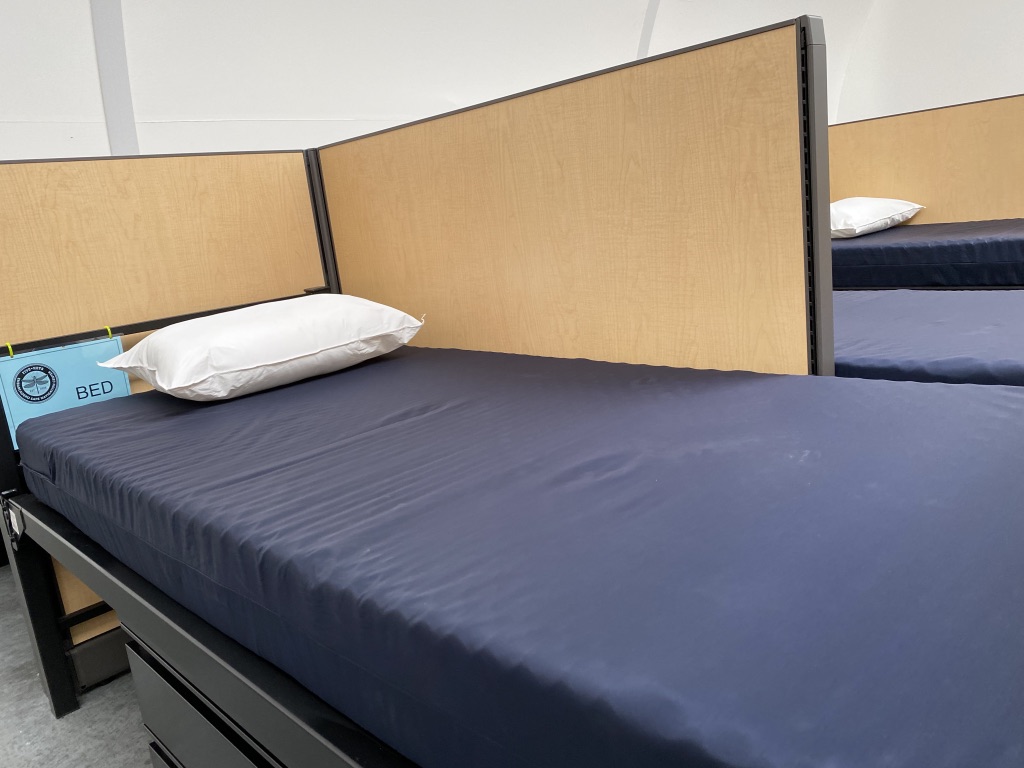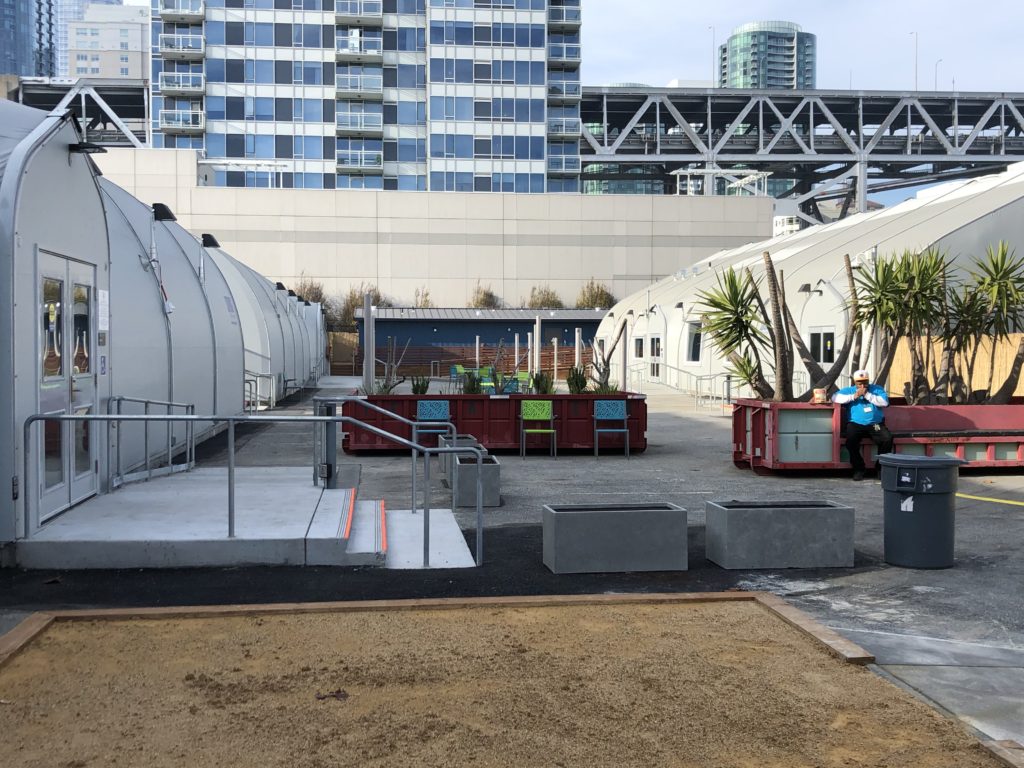If your tickets to the Giants game are in sections 126 through 135 at Oracle Park, then you might meet Joanna Shober.
She’s worked in guest services for the Giants the last eight seasons, guiding people to their seats and offering her assistance as needed. In between baseball seasons, she’ll take similar jobs at the Chase and Moscone Centers.
“I help people,” she said succinctly, seated at a lime green table last winter with a Giants ballcap shielding her from the sun and a Fitbit wrapped over her left wrist that she found one day on the street. Now it’s Joanna’s turn to receive a little extra help and she explains how she found a temporary housing at the new Embarcadero Navigation Center.
Joanna, whose nickname is “Squeaky” amongst friends, has lived in the Bay Area since 1981, sometimes housed and sometimes not. When she’s having an offseason and can’t find work, she lives on the street. Joanna camped out by the Ferry Building along The Embarcadero for the past year until an invitation arrived for a bed at the recently-constructed Navigation Center nearby on Beale Street.
This was in early January and Joanna was with three companions near their camps close to the Embarcadero’s clock tower. They were approached by members of the San Francisco Homeless Outreach Team, who don jackets with the acronym HOT on their backs, during their daily walks reaching out to folks in the neighborhood. The Embarcadero SAFE Navigation Center had opened a week prior and joining the team for their routine that day was Mayor London Breed.
After building trust and a friendship with persons living on the street in the Embarcadero neighborhood, the Homeless Outreach Team extended an invitation to Joanna and the other three to become guests of a Navigation Center. It’s how the system was designed: Relationships with folks on the street are forged, an offer is made and the individual is invited to temporarily live at the shelter as they work on finding permanent housing and gaining social services.
It’s not a first-come, first-served shelter and camping around the Center for chances to get in is discouraged.

Joanna accepted the invitation, along with two of her three companions, and they were welcomed inside the center. Although the fourth person wasn’t yet ready for services, the Homeless Outreach Team would be back the next day to continue building trust.
Since the onset of COVID-19, the Navigation Center has followed the guidance of the Department of Public Health. There’s been a pause on reservations and new placements, enhanced janitorial and hygiene services and some rules that could result in a Denial of Service were reduced to support people to shelter in place. Since DPH never issued a health order mandating individual shelter in place, guest of the Navigation Center were allowed to come and go, but all were encouraged to shelter in place.
Meals are provided, laundry is available, shower and bath facilities are kept clean and there’s computer access near a communal television. Beds are laid out in dormitories and housed under structures from the company Sprung who specialize in industrial and commercial markets, as well as homeless navigation shelters.
Dormitory B waits for occupants and for now is mostly empty. The Embarcadero Navigation Center was designed to serve up to 200 guests at a time but amidst COVID-19 abiding by DPH guidance regarding bed spacing and layout, it now has 88 active beds at the site.
Dormitory B is an airy space, well ventilated for having no windows and smells like fresh polyurethane-coated fabric. At the front desk of the dorm is a copy of DeVon Franklin’s “The Success Commandments” next to some sticky notes and a nasal Narcan device. The L-shaped dorm cubicles have a few drawers for storage and clothing and the navy-blue cots are doubled padded.
Each guest is assigned a personal care manager who assists in signing up for the General Assistance Program and housing programs. If a guest is exhibiting a commitment to exiting homelessness, they will not be asked to leave and can remain at the Navigation Center until their pathway forward is created. However, guests will be asked to leave if the safety of those around them is threatened.
The first Navigation Center opened March 2015 and hits its 5-year mark with six shelters in operation and two more on the way expected by the end of the year: 75 beds for a Transition Aged Youth center located at 888 Post Street and 200 beds set for 33 Gough Street. From 2015 through the end of 2018, 46% of Navigation Center exits were either to permanent housing or reunifications with family or friends through the Homeward Bound program.
Abigail Stewart-Kahn, director of strategy and external affairs with DHSH, explained how the success of Navigation Centers, with nearly 2,500 individuals finding homes over the last five years, should not necessarily be gauged by the number of folks who did not exit homelessness.
“The majority of those exits, the other side of the coin, were people leaving on their own. They either declined services or left by their own choice,” she said. “It’s important to emphasize that success should not be measured that way. The success is if people what to come inside the center; do they stay, do they build a community—do they get safe?”
In reference to folks who decline services or an invitation to the Navigation Center, Ms. Stewart-Kahn says the Homeless Outreach Team understands they need to remain consistent and dependable to eventually earn the trust of a person living on the street while respecting their individual personal situation.
“You say great, we’ll come back and see you tomorrow,” she said. “If we can pivot away from the idea of what’s wrong with you to what happened to you, then we can start to build that compassion and better help people.”
////
The flat parcel of asphalt along The Embarcadero was only a parking lot with tire marks and erosion last baseball season, often used by sports fans before the half-mile stroll south to the Giants’ stadium.
All that remains of the former function of Sewall Lot 330, the 2.3-acre plot across from Piers 30-32, is a canvas of painted white lines used to separate parking spaces.
Sewall Lot 330, once used for temporary parking, has been adapted into temporary shelter for some of the Embarcadero neighborhood’s more vulnerable residents. It’s the latest Navigation Center to go up from the Department of Homelessness and Supportive Housing. It’s large enough to provide temporary housing for eventually 200 guests with room, board, safety and social services. As well as 200 new opportunities for them to find a way home.

This Navigation Center is not only the largest shelter yet in terms of its quantity of beds, but it was perhaps the most disputed, receiving pushback from local residents, businesses and other non-profits who coalesced to form the Safe Embarcadero For All community organization to voice concerns about public safety. There were dual fundraising efforts, either supporting the construction or the delay of the homeless shelter, and a months-long legal dispute that ended in favor of the center’s construction.
Opened during the final days of 2019, the barren blacktop now supports three granite grey fabric membrane structures, about two stories high and maybe half-a-football field in length each. They encompass nearly the entire lot with an outdoor center area with neon-colored chairs and planter boxes for growing saplings courtesy of the Friends of the Urban Forest.
The clamor of the city behind the wooden fence, intensified by the constant rush of traffic from the Bay Bridge a mere block away, becomes white noise inside the triangular lot. Guests can spend their full days inside the safety of the shelter or choose to go out. Whenever they return, they sign in, receive a full pat down with a metal-detector and if they possess a weapon, they log it to be stored during their stay.
Mike Tillman is one the multiple employees with Five Keys, a nonprofit charter school operator contracted by the city to operate the Navigation Center. He wears the uniform of a sky-blue t-shirt and is the key master for the bicycle storage facility near the front door.
Five Keys and Heluna Health, the service that runs the Homeless Outreach Team, are always hiring—particularly people who have been homeless themselves. Both organizations have job boards on their websites with a multitude of open positions for a variety of positions and skillsets. Learn more at fivekeyscharter.org and helunahealth.org under the careers tab.
Mr. Tillman was part of the team that set up the Embarcadero Navigation Center, which opened on January 30. “I was helping to bring in tables and break up boxes,” he said. “At first, there were five people then I looked up and there was 20 people—then 80!”
The Embarcadero shelter was announced in March 2019 and was swiftly met with push back from residents in the neighborhood. Critics challenged the city’s planning department’s decision to exempt the project from an environmental review to expedite the construction of the shelter and argued that the shelter would attract further public alcohol and drug consumption, police interventions, property crime, personal assaults and additional homeless encampments.
Two online fundraisers through GoFundMe were created in response; to raise money for the legal fees to counter the Center’s development, Safe Embarcadero For All raised $102,005. Responding to this campaign was A Safer Embarcadero For All which supported the Center and raised $176,015. [The Coalition for Homeless, which operates the Street Sheet, was the benefactor of this donation.]
The Port of San Francisco created the Embarcadero SAFE Navigation Center Advisory Group to allow concerned community members the opportunity to communicate with the organizations operating the shelter. Since August 2019, there have been public meetings held almost monthly.
Wallace Lee, speaking on behalf of the organization Safe Embarcadero for All, said such meetings have been a good way for the community to let the City and Navigation Center operator, Five Keys, know about problems.
“I have found that the City and Navigation Center representatives genuinely want to be helpful in resolving the issues, but they don’t really have the ability to do anything meaningful, which can be frustrating,” Mr. Lee said.
He described his disappointment in an increase of open drug use, drug dealing and improperly discarded syringes he’s observed in the area around the Navigation Center since its opening. He also said he felt betrayed by the City’s promises that the Navigation Center would not attract encampments.
“While the City has generally been responsive to reports of blocked sidewalks and menacing behavior towards pedestrians, encampments have been appearing at an increasing rate around the Navigation Center,” Mr. Lee said. “Some of the encampments are from those seeking to get a space in the Navigation Center, but surprisingly, some have been from Navigation Center guests who refuse to sleep indoors.”
Posted around the Embarcadero Navigation Center are blue, lamented notices with a phone number advising neighbors to contact the Center if anything needs to be picked up, cleaned or removed. The Center’s operators explained that camping in the parameter is discouraged and folks are informed that it does not enhance the likelihood of an invitation.
Ms. Stewart-Kahn says that she’s received a number of positive calls and emails from neighbors who commend the Center for its cleanliness and even offer to help volunteer. She acknowledges the concerns from disappointed neighbors and encourages a little extra empathy.
“That’s the work and we’re thankful they’re raising question,” she said. “We just hope they raise those questions and understand the humanity and dignity of the people who are in homelessness. Then we’re very happy to engage with conversations.”

